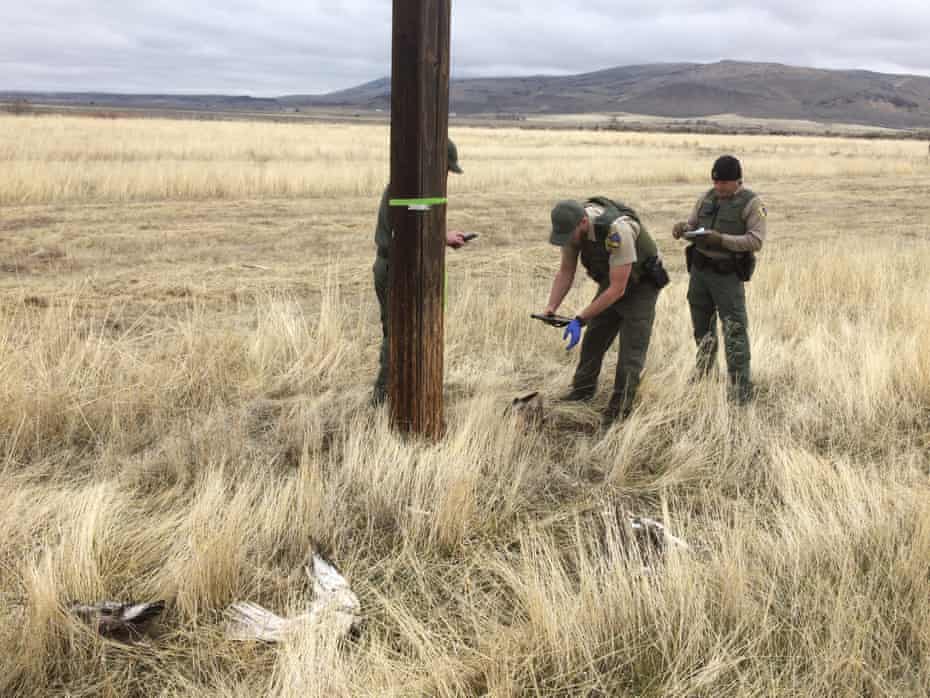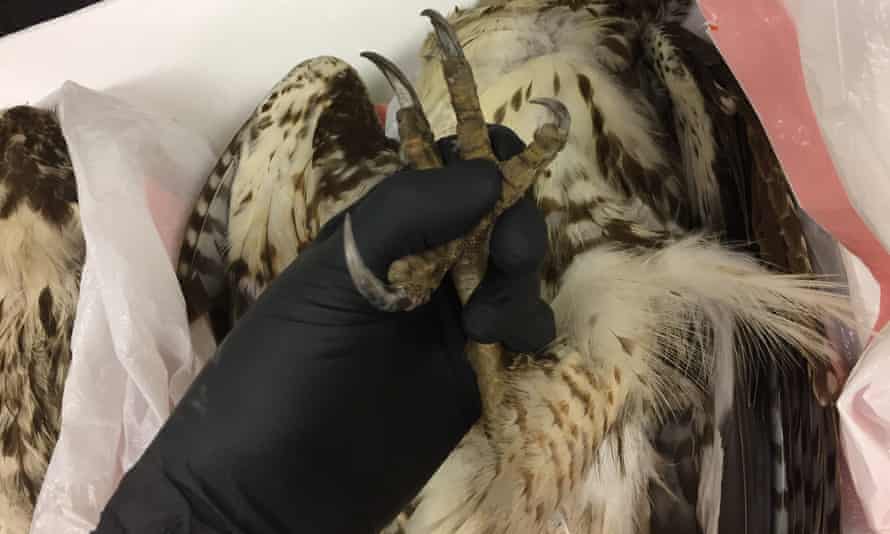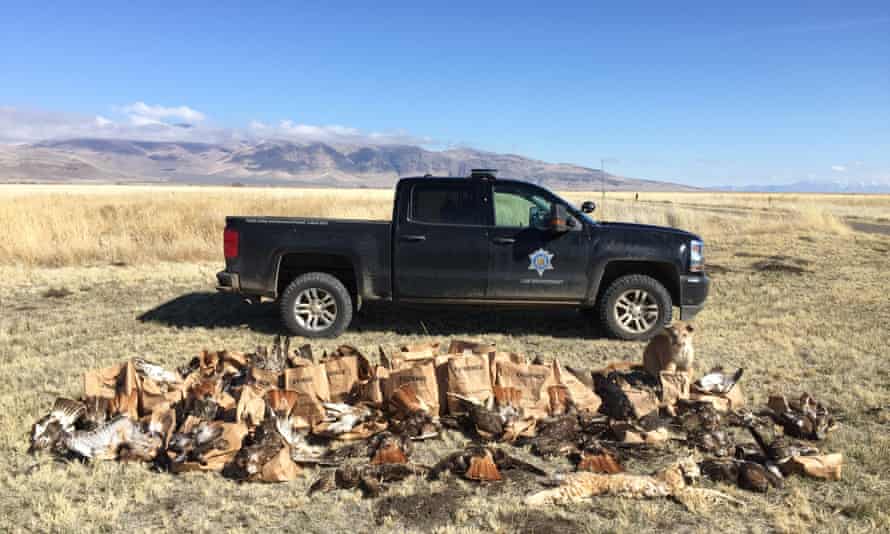The California department of fish and wildlife relies on an intricate network of citizen-informants to help do its job. The agency’s secret tip line is a critical tool in the fight against wildlife crimes because, in more rural areas of the state, a single wildlife officer can be responsible for thousands of miles of territory.
Todd Kinnard is one such officer – tasked with overseeing agency operations across the expansive Lassen county, five hours north-east of San Francisco by car. He was on duty when an anonymous tip came in that someone in the county was shooting raptors, birds of prey such as red-tailed and ferruginous hawks.
Raptors are not typically the subject of poaching tips. They are agile, apex predators that – due to a diet consisting largely of pests such as rats, snakes, and mice – tend to coexist with humans rather than compete with them.
Kinnard took the tip with a grain of salt. In Lassen county, it is not unheard of for neighbors to weaponize the department’s anonymous tip line against one another out of spite. Because something as seemingly innocuous as taking one too many fish from a local pond can result in substantial government fines, grazing-rights or property-line disputes can quickly mushroom-cloud into frenzies of sometimes bogus, sometimes legitimate, tit-for-tat poaching complaints.
Kinnard drove out to the site of the alleged raptor killings to carry out a preliminary, informal knock-and-talk inquiry. It was a large-tract property, roughly 80 acres, in the unincorporated town of Standish. The property sat perched on the banks of the Susan River, a few miles east of the county seat, Susanville. The owners, Richard Parker and his wife, Tonya, were not at home at the time.
But what Kinnard saw upon entering the property was stomach-churning. A cottonwood tree near the Parkers’ home was strung up with grisly ornamentation – several dead raptors, all at varying stages of decomposition. Other bodies were scattered around the tree’s base, approximately a dozen in all.
Kinnard was not prepared to bag and tag the gruesome cache of evidence dangling from the cottonwood tree. He seized what evidence he could and took the bodies to the fish and wildlife department’s forensic laboratory in Sacramento.

The agency’s raptor specialist examined the carcasses and was able to determine species, with corresponding protected statuses. Causes of death proved more elusive, however. The bodies had been left to field for quite some time.
Still, the probability of a dozen birds of prey dying of natural causes at the same location is spectacularly low. As the Sacramento laboratory got to work on identifying causes of death, Kinnard proceeded with his own investigation. The dead raptors recovered on that day in 2018 were only the tip of a blood-red iceberg.
Richard Parker, a seemingly ordinary country gentleman, appeared to have a secret, sadistic hobby and the anonymous tipster had led Kinnard to uncover one of the bloodiest poaching cases in California history.
An anti-government streak
Lassen county is tucked away in the sparsely populated north-east of California. It sits north of Lake Tahoe along the Nevada border, and east of Redding, the last major population center before the vast wilderness stretching between northern California and southern Oregon.
Lt Kyle Kroll, who oversees game wardens in the area, describes the region around Susanville as the Honey Lake Valley, a unique ecosystem straddling a transition zone between the desert and the mountains. “But with a lot of water,” he says, “because the aquifers flow eastward into the desert. It’s a perfect habitat for raptors, because it’s a rich area that attracts a lot of their prey.”
Topography aside, Lassen is an entirely different world, culturally speaking, from the metropolitan sprawl of the Bay Area to its south-west, or even the exurbs and rich farmland of the nearby Sacramento Valley.
The population in 2019 was just over 30,500 residents, less than half that of the San Francisco suburb of Palo Alto, spread out over more than 180 times the square mileage. It is the kind of place people go to get away from the congestion of coastal California’s urban-suburban sprawl, and the many customs and regulations woven into life there.
There is a palpable anti-government streak embedded in the culture of Lassen county – a “don’t tread on me” mentality that often pits the priorities of local residents against those of state conservation officers such as Kroll and Kinnard.
California’s sole pack of wild wolves inhabits a territory encompassing parts of Lassen county. There is no love lost between the endangered canines and area ranchers, who view the pack as a direct threat to their livelihoods. (Wolves occasionally feed on cattle and sheep.)
In December of 2020, a state investigation into the shooting of a protected wolf in Lassen county laid bare these tensions by implicating a 23-year-old, sixth-generation rancher, Brett Gagnon.

“I can’t believe you guys would waste your time to investigate somebody for shooting a miserable wolf,” Gagnon’s grandfather told state agents as they executed a search warrant on the family ranch.
Gagnon was not ultimately charged with the killing. Analysis of the bullet recovered from the wolf’s body did not match any of the guns seized from the Gagnon home. The case remains open.
The ordeal did little to warm relations between the fish and wildlife department and county residents. And perhaps a flavor of that tension informed the politics of one Richard Parker.
The stakeout
As the fish and wildlife department’s forensic examiners poked and prodded the bodies recovered from the Parker property, Todd Kinnard remained disturbed and restless over what he could only imagine had occurred there. He knew the physical evidence against the Parkers was damning, but not conclusive, and the agency would need solid proof that one or more members of the family were behind the brutal raptor killings in order to bring about any kind of justice.
Kinnard enacted what state agents call a Code Five surveillance plan. In March 2018, for several mornings in a row, he took up a vantage point on a neighboring property and, using a high-powered scope, staked out the Parker home.
On one of these mornings, he witnessed an individual emerging from the house, rifle in hand, later determined to be Parker, according to department officials.
Kinnard says Parker took up position in the yard, raised his rifle, and shot off several rounds in different directions. Kinnard recalls watching nearby foliage explode to life as birds fled the vicinity. He now had sufficient probable cause to corroborate the initial tip and secure a search warrant.
The warrant was served on the Parkers by a team of wildlife officers in the early hours of 11 March 2018.
“I’ll be honest, we thought we were only going to find what was already around that tree,” Kroll recalls. “But that was just one of the specks of evidence that we found.” The true extent of the horror would stretch from fence to fence.
Recollecting the broader examination of the property, Kroll describes a scene of complete carnage within a 300-yard radius of the Parker home. “Every bird within reach of his house, anything he could hit, was lying there on the ground. Dozens and dozens of carcasses.”

“It was just an unbelievable amount of evidence,” Kroll says. The team needed to restrategize. Time was of the essence – many of the bodies had clearly been decomposing for some time. Some were little more than skulls and delicate wing bones.
State wildlife officers assembled in a kind of phalanx formation and began meticulously surveying the property in four waves. The first wave made initial identifications of body locations, marking points on a GPS app. The second took photographs; the third recorded copious notes on the state and positioning of the carcasses. The fourth collected and bagged them.
The process created a map of the butchery, which investigators later transposed on to satellite imagery of the Parker property. It provided unsettling insight into Parker’s bloody method.
“As he entered his property by vehicle, any raptors he’d see perched along the access road he’d shoot,” Kroll says. “It was a row of dots along the road and around his home.”
Parker, for his part, was surprised by the raid, yet calm, Kroll recalls. Kinnard obtained an admission on the scene from Parker that he had shot a red-tailed hawk just the day before. The justification offered was that he believed the raptors were killing off local game birds.
“He was an upland game hunter,” Kroll says, conceding that raptors are known to predate on certain species of quail, dove and pheasant, favored by sportsmen. “He said he thought he was doing the game bird population a favor by eradicating the predators.”
Kroll believes this may have been Parker’s original intent, “but it eventually became a sick sport”, he speculates. “There might have been an adrenaline rush; people get addicted to that. We see that from time to time with the larger-scale poaching cases.”
Likewise, the map of Parker’s killings seemingly refutes the notion that his motives lay chiefly with preserving the area game bird population. All of the bodies recovered from Parker’s property were killed along the access road and in the immediate vicinity of his home. There is no evidence to suggest he made treks further afield to enact this purported, self-directed population-control program.
That same day, Parker was arrested and booked into Lassen county jail on charges including unlawful killing of birds of prey, killing of migratory non-game birds in violation of the federal Migratory Bird Treaty Act, and possession of wildlife unlawfully taken.
The man who relished the hunt
The man wildlife agents took into custody that day had not necessarily lived a life indicative of a future sport killer. Richard Earl Parker was born and raised in Lassen county. He graduated from Susanville high school, and after receiving his bachelor’s degree from Sacramento State University in 1973, he returned to the area to settle down.
He became a significant figure in the Honey Lake Valley, according to local people who spoke with the Guardian on the condition of anonymity. Parker still has friends in the area. Susanville is small. And even two years after his conviction, anxiety about retaliation persists. “They [don’t] want to stir up anything,” one local resident explains.

For 20 years, Parker was the area milkman. When the home milk-delivery business died out, he pivoted to insurance sales. He served in the Lassen County Chamber of Commerce for 15 years and participated in local theater productions.
Members of the community in Susanville say Parker’s local status was polarizing. He was intensely liked by his circle of friends and confidants and intensely disliked by others.
“A lot of people from his community called us after the arrest came out,” Capt Patrick Foy of the department of fish and wildlife says. “They acknowledged that he was a powerful, well-connected guy in the community, and there was concern he was not going to be prosecuted fairly.”
Indeed, local residents tell the Guardian that Parker viewed the Honey Lake Valley as a manor and himself as its lord.
And like all standard-issue country gentlemen, Parker relished a stalk and a hunt.
Sport hunting in many parts of rural America sits at an awkward philosophical crossroads between conservationism and libertarianism. On the one hand, there is a rationale for the preservation of wild lands, which arises from a mixture of legitimate appreciation for nature and simple supply-and-demand economics: better habitats attract more creatures to hunt. On the other hand, there is a natural tension between the autonomy of the hunter and the conservationist machinations of the state.
Parker seemingly resided, for a time, at this crossroads. But the tension perhaps proved untenable for him.
In the late 1990s, shortly after purchasing the property in Standish, Parker asked state forestry authorities to set a controlled fire on his land. Parker thought the riverside property was a perfect nesting ground for waterfowl. But at the time, it was infested with whitetop, an invasive weed that chokes out competing grasses.
The controlled blaze, administered in November 1999, wiped out a mat of whitetop and made way for the area’s natural weeds and grasses to take root.
“What I was going to grow was wildlife, little critters, waterfowl,” Parker told the Lassen County News just after the fire. “My interest is to have birds and wildlife around me.”
But something in Parker’s philosophy would change in the ensuing years. The self-described hunter and naturalist began advocating seemingly contrary positions to the conservationist movement.
In 2013, he told the Lassen County Times, another local newspaper, that he hoped a commission tasked with making countywide economic projections would prioritize logging, largely viewed as one of the most ecologically devastating industries in the world. “This committee should recommend to the people that our biggest opportunity for economic growth is timber,” he said.

The inciting incident for this change of heart may have been a small-town political scandal, at the heart of which was Parker himself.
Despite the shades of anti-government spirit that pervade Lassen county, Parker seemed to crave public office. He has made several runs at various positions – most recently, it appears, in 2008, for the Lassen Community College board.
In 2000, he was elected director of the Lassen municipal utility district, the public utility provider for the county. Less than a year into his tenure, citizens launched a vigorous recall effort against Parker and his fellow board members.
Organizers accused Parker of “abdication of authority”, “violation of public trust”, “abuse of power”, and “intentional misuse of public funds” arising from a proposed 162% rate hike in electrical costs for the county that year.
Public meetings in response to the proposed rate hike were “vile” and “disorderly”, according newspaper reports from the time, with community members lodging concerns that such a move would destroy the county’s fragile economy.
Richard Parker was effectively villainized by the whole ordeal. The place to which he devoted years of time and effort cultivating a reputation seemed to be rejecting him. And he scrambled to shift blame – first, to unnamed local environmentalists, allegedly to blame for preventing the construction of more power plants.
“Bunny huggers”, he called them in one public meeting, with palpable, newfound derision.
The crimes come full circle
Nearly two decades after the recall effort, Parker found himself on trial for conduct that was arguably the polar opposite of bunny hugging. In April of 2019, Parker, then 68, pleaded guilty to crimes associated with poaching in excess of 150 birds of prey and other wildlife. He was sentenced to three months in jail, a $75,000 fine, and five years’ probation. Terms of his probation forbid him from possessing firearms or engaging in hunting or fishing of any kind.
Wildlife officers are reluctant to label crimes like Parker’s “serial killings”, as it conflates terminology associated with homicide and animal poaching. Still, they acknowledge a distinction between the crimes of Richard Parker and your average poacher.
“Poaching can be taking one too many trout from a pond, or redirecting a creek on your own property,” says Foy. “But there are individuals who seem to enjoy killing for the sake of killing,” he says, noting that in cases where the body count is as high as Parker’s, it is difficult to identify a motive other than rank cruelty or sadism.
“Who knows what the true extent was,” Kroll says of Parker’s crimes. “We uncovered a hundredfold more than we assumed we’d find. But things don’t last long in the wild. The true extent of the carnage was probably much greater. We truly think that his kill number was so much higher than what we were able to collect.”
Kroll speculates Parker’s conviction was largely attributable to the strength of the government’s case against him, primarily due to forensic assistance from the federal Fish and Wildlife Service.

“Because these birds are federally protected, we were in constant contact with them,” Kroll says. “They were an immense help because we were able to ship the [dead] birds up to their lab in Ashland, Oregon, which is really world-renowned in wildlife forensics. They spent an immense amount of time going through every piece of evidence submitted and writing a comprehensive report for each – way beyond anything we could have compiled locally.”
Ultimately, despite committing several federal crimes, Parker was tried in state court by the office of the former California attorney general Xavier Becerra. This, Kroll says, allowed for the story of Richard Parker – bloody as it may be – to inspire a happy ending.
“Because of the case disposition, a huge sum of money went back into community conservation and education programs,” he explains. Per the California fish code, 10% of fish and wildlife-related fines go to individual county fish and game commissions, which can reinvest those funds to the benefit of local ecology. Seventy-five hundred dollars goes a long way in Lassen county.
“They might donate the money to a fishing program for inner-city youth,” Kroll says, “Or wildlife projects like installing [water] guzzlers for antelope in the high desert.
“It’s a nice way of bringing wildlife crimes full circle,” he says. Despite himself, Richard Parker, one of the most extensively prosecuted poachers in California history, became an indirect bunny hugger after all.